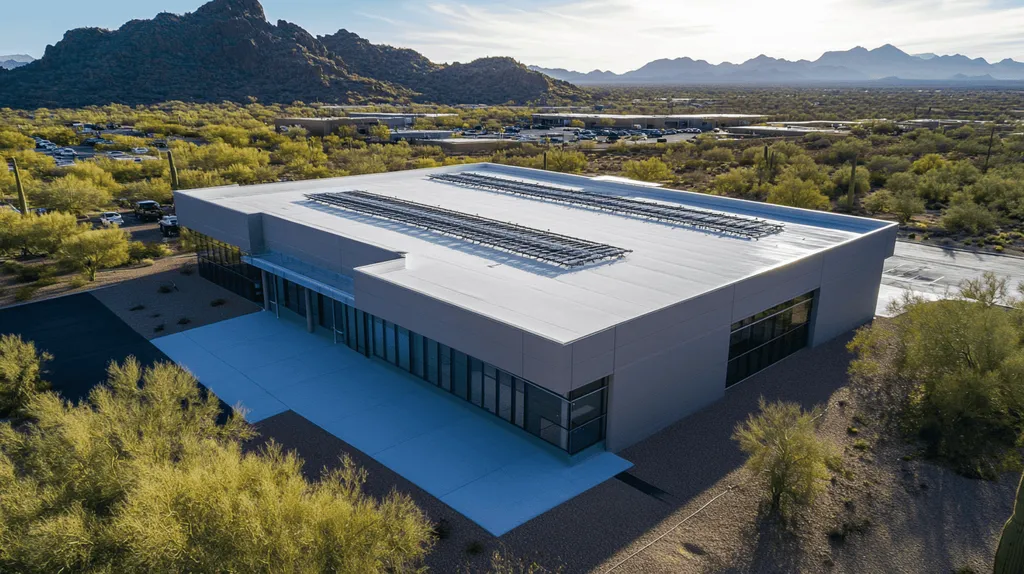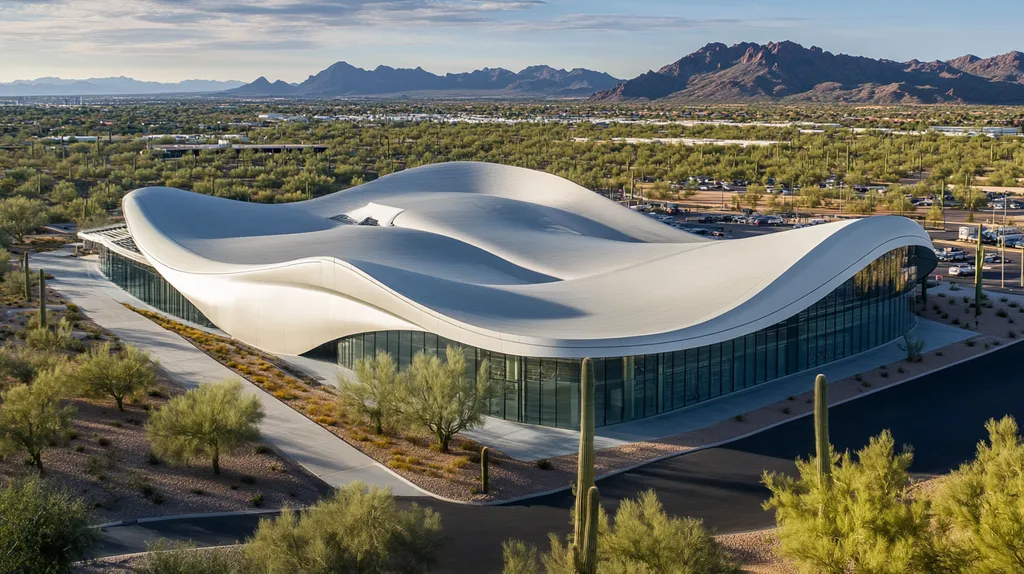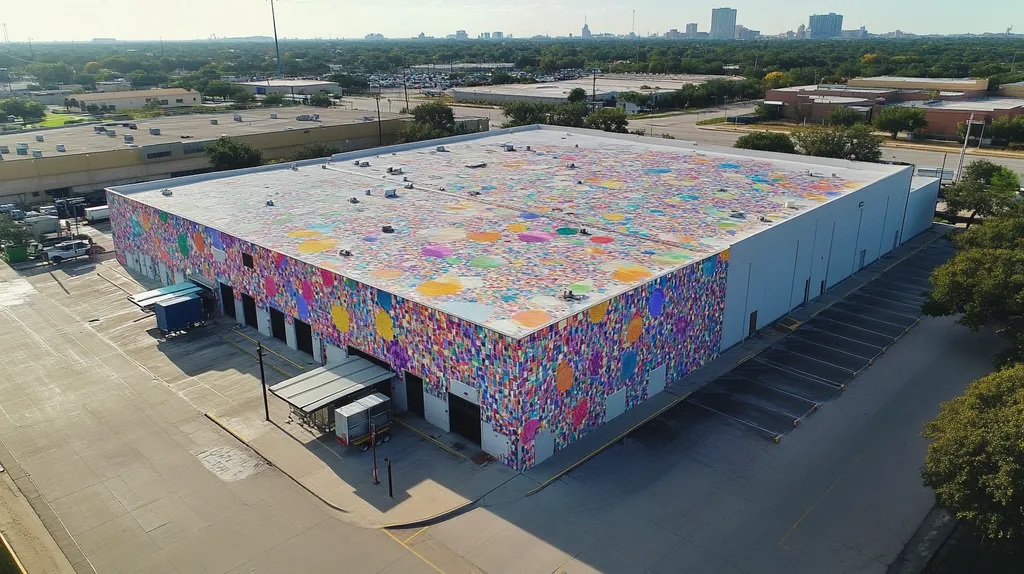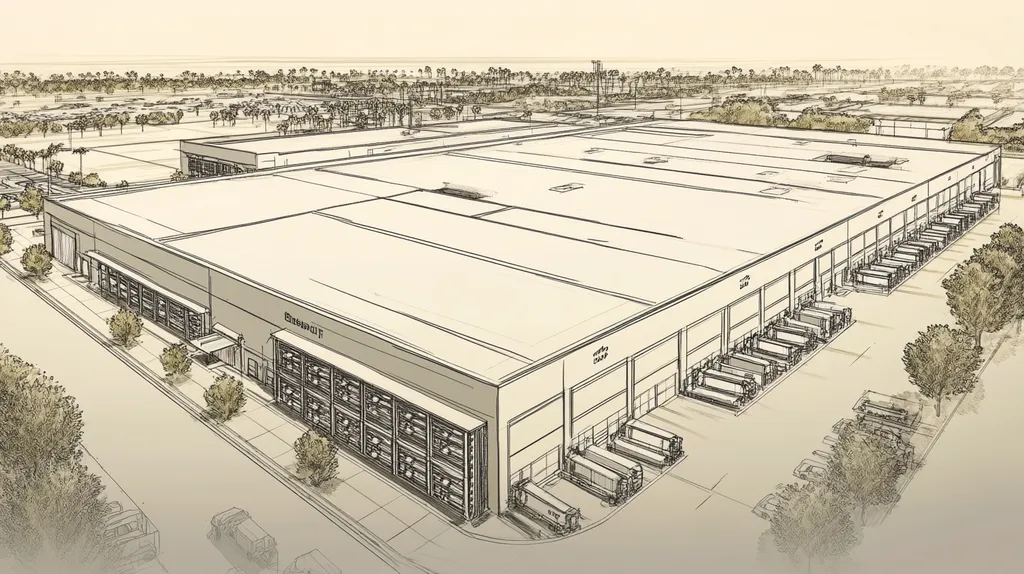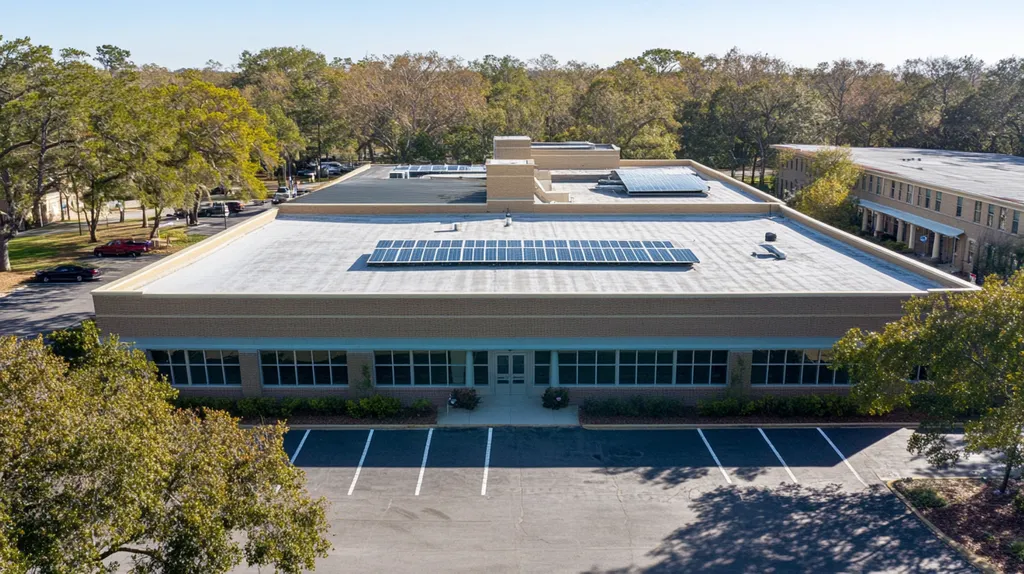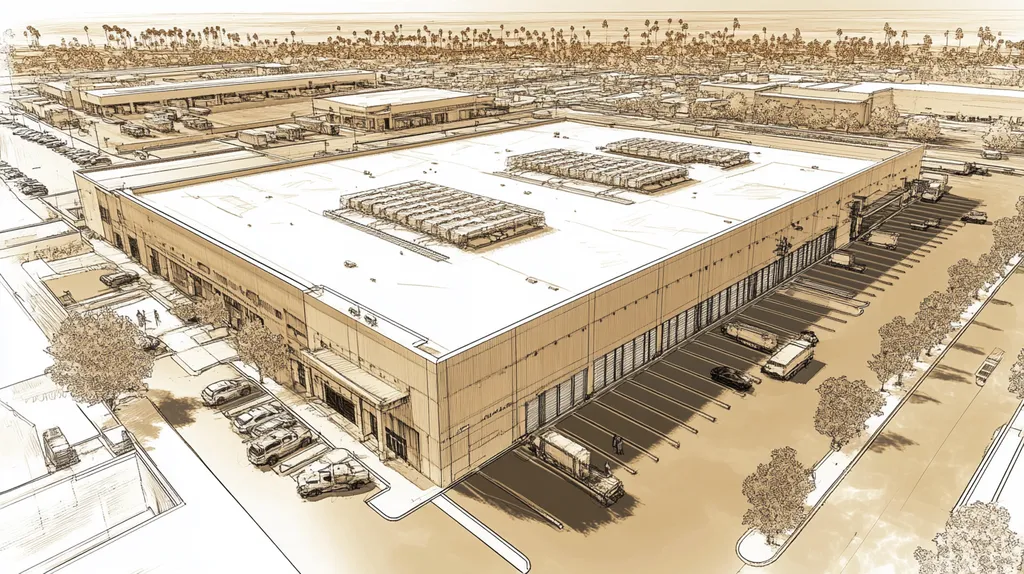Welcome to today’s Battle Royale featuring two roofing heavyweights: “Metal” in the east corner versus “Membrane” in the west!
Tonight’s showdown pits these contenders against each other across six punishing rounds designed to test every aspect of their performance for aesthetic choices impacting commercial roof insurance.
At stake? Millions in potential costs, decades of building protection, and the critical performance demands of modern commercial and industrial facilities.
Our professional judging panel will evaluate each round on technical merit, real-world performance, and value delivery. After all six rounds, we’ll declare our ultimate champion.
Ladies and gentlemen, facility managers and building owners… it’s time to rumble!
ROUND 1: INITIAL COSTS & INSTALLATION
When selecting a commercial roofing system, the initial investment can make or break your budget – and your insurance rates. Understanding these costs is critical for long-term financial planning.
Today’s commercial property owners face mounting pressure to balance durability with cost-effectiveness, as initial roofing choices can impact insurance premiums for decades to come.
Let’s examine how metal and membrane roofing systems stack up in terms of upfront expenses, installation requirements, and project duration – three factors that significantly influence both immediate costs and long-term insurance considerations.
Material Expenses
Material costs represent the foundation of any roofing project’s budget. Quality and durability often correlate directly with price, making this a crucial consideration for long-term planning.
Metal roofing systems typically command premium prices, ranging from $10-15 per square foot for commercial applications. However, their exceptional durability and fire resistance often translate into more favorable insurance rates.
Membrane roofing offers a more economical alternative, usually costing $4-8 per square foot. While this lower initial investment appeals to many property owners, insurance companies may view these systems as higher risk.
Due to their contrasting cost-benefit profiles, this category results in a “TIE” between the two options.
Installation Complexity
Installation complexity directly affects both project costs and potential risks during the construction phase. More complex installations increase the likelihood of errors that could impact future insurance claims.
Metal roofing demands specialized expertise and precision installation techniques. The complex nature of metal roof installation can extend project timelines and increase labor costs by 30-40% compared to membrane alternatives.
Membrane roofing systems offer straightforward installation processes that require less specialized training. This simplicity reduces the risk of installation errors and typically results in lower labor costs.
The clear efficiency advantage gives membrane roofing the “ADVANTAGE” in this category.
Project Timeline
Project duration affects both immediate costs and business disruption. Longer installation periods increase exposure to weather-related risks and potential insurance claims during construction.
Metal roofing installations typically require 50-100% more time than membrane alternatives. This extended timeline increases exposure to weather events and potential damage during installation.
Membrane roofing can often be completed in half the time of metal installations. This shorter exposure window reduces construction-phase risks and allows businesses to resume normal operations sooner.
The significantly shorter installation period gives membrane roofing another clear “ADVANTAGE.”
ROUND 1 WINNER: Membrane Roofing
ROUND 2: DURABILITY & LIFESPAN
When evaluating commercial roofing options, durability and lifespan directly impact both immediate insurance costs and long-term financial planning. Every year of additional service life means thousands in saved replacement costs and reduced insurance premiums.
The choice of roofing materials affects not only the aesthetics and function of your commercial space but also the hard financial bottom line in terms of insurance rates and coverage options. (source: Renew Home Exteriors)
Weather Resistance
A roof’s ability to withstand severe weather events directly impacts insurance premiums and coverage options. Superior weather resistance means fewer claims and lower long-term costs.
Metal roofing systems excel in this category, offering exceptional resistance to high winds, hail, and extreme temperatures. Their rigid structure and interlocking panels provide superior protection against wind uplift and water penetration.
Membrane roofing, while flexible, can be more susceptible to punctures and tears during severe weather events. Wind uplift and hail damage pose particular challenges for membrane systems.
The superior weather resistance capabilities give metal roofing the ADVANTAGE in this category.
Maintenance Requirements
Regular maintenance needs affect both operational costs and insurance risk assessments. Systems requiring less frequent maintenance typically qualify for better insurance terms.
Metal roofing demands minimal maintenance beyond periodic inspections and basic cleaning. Their durable finish and robust construction eliminate many common maintenance concerns.
Membrane roofing requires more frequent inspections and maintenance to prevent seam failures and address ponding water issues. These ongoing maintenance needs can impact insurance risk assessments.
The lower maintenance requirements give metal roofing another clear ADVANTAGE.
Long-Term Performance
Long-term performance reliability influences both replacement cycles and insurance premium calculations. Systems with proven longevity often qualify for premium discounts.
Metal roofing systems typically last 40-50 years or more, providing predictable performance throughout their service life. This extended lifespan translates to lower lifetime costs and more stable insurance rates.
Membrane roofing generally requires replacement every 15-25 years, creating more frequent periods of vulnerability and potential claims. This shorter lifespan can result in higher insurance costs over time.
The significant difference in service life gives metal roofing a third ADVANTAGE.
ROUND 2 WINNER: Metal Roofing
ROUND 3: PERFORMANCE FACTORS
Every commercial property owner faces critical decisions about roofing that impact both aesthetics and insurance costs. The right choice between metal and membrane roofing can mean the difference between stable, manageable premiums and years of escalating costs.
Today’s insurance carriers scrutinize roofing performance more closely than ever, making performance factors a key determinant in coverage rates and availability.
Weather Impact Resistance
A roof’s ability to withstand severe weather directly affects insurance premiums and coverage options. Strong weather resistance means fewer claims and more favorable rates over time.
Metal roofing demonstrates exceptional resistance to high winds, hail, and extreme temperatures. Its rigid structure and interlocking panels provide superior protection, often exceeding most local building codes for impact resistance.
Membrane roofing systems, while flexible, show greater vulnerability to punctures and tears during severe weather. Their susceptibility to wind uplift and hail damage often results in more frequent claims and higher insurance costs.
The superior weather protection capabilities give metal roofing the ADVANTAGE in this category.
Fire Safety Performance
Fire resistance ratings significantly influence both insurance availability and premium costs. Better fire performance translates directly into more favorable coverage terms.
Metal roofing systems carry Class A fire ratings and are naturally non-combustible. This inherent fire resistance often qualifies buildings for premium discounts and expanded coverage options.
Membrane roofing typically requires additional treatments or underlayments to achieve comparable fire ratings. Even with these additions, many insurers consider them a higher fire risk than metal alternatives.
The natural fire resistance advantage gives metal roofing another clear ADVANTAGE.
UV and Temperature Stability
Long-term stability under harsh sunlight and temperature extremes affects both maintenance needs and insurance risk assessments. Systems that maintain their integrity longer typically qualify for better rates.
Metal roofing excels at reflecting UV radiation and handling extreme temperature changes. This natural stability means fewer heat-related issues and lower cooling costs for the building below.
Membrane roofing can degrade more quickly under intense UV exposure, leading to more frequent repairs and replacements. This vulnerability often translates into higher risk assessments from insurers.
The superior stability gives metal roofing a third ADVANTAGE.
ROUND 3 WINNER: METAL ROOFING
ROUND 4: MAINTENANCE REQUIREMENTS
In today’s challenging commercial property market, maintenance requirements can make or break your insurance premiums. Well-maintained roofs can reduce insurance costs by up to 25%, while neglected systems often trigger premium increases and coverage restrictions.
Property owners must weigh not just the immediate maintenance needs, but how their roofing choices will impact decades of insurance costs and coverage options.
Routine Inspection Requirements
The frequency and complexity of required inspections directly impact both maintenance budgets and insurance risk assessments. Systems requiring less frequent professional inspection typically qualify for better insurance terms.
Metal roofing systems generally need only annual inspections, focusing primarily on seam integrity and fastener tightness. This simplified inspection protocol reduces both maintenance costs and the likelihood of overlooked issues.
Membrane roofing requires quarterly inspections to check for tears, punctures, and seam separation. This increased inspection frequency raises both maintenance costs and the potential for undetected problems.
The lower inspection burden gives metal roofing the ADVANTAGE in this category.
Repair Complexity
The complexity of common repairs affects both maintenance costs and the potential for additional damage during repairs. Simpler repair procedures reduce the risk of installer error and subsequent insurance claims.
Metal roofing repairs typically involve straightforward procedures like fastener replacement or seam sealing. These simple repairs can often be completed quickly with minimal risk of causing additional damage.
Membrane roofing repairs frequently require extensive patching or seam reconstruction. These complex procedures increase both repair costs and the risk of workmanship errors.
The simpler repair requirements give metal roofing another ADVANTAGE.
Long-Term Maintenance Costs
Maintenance expenses over a roof’s lifespan significantly impact total ownership costs and insurance considerations. Lower maintenance requirements typically translate to more favorable insurance terms.
Metal roofing systems demand minimal ongoing maintenance beyond basic cleaning and occasional recoating. This predictable maintenance schedule helps control long-term costs and insurance risk assessments.
Membrane roofing requires regular resealing, patching, and eventual membrane replacement. These recurring maintenance needs often result in higher insurance premiums due to increased risk potential.
The reduced long-term maintenance burden gives metal roofing a third ADVANTAGE.
ROUND 4 WINNER: Metal Roofing
ROUND 5: SUSTAINABILITY CREDENTIALS
Today’s commercial property insurers increasingly factor sustainability into their premium calculations. Buildings with eco-friendly roofing systems can qualify for up to 15% lower rates, while those with inefficient designs face mounting surcharges and coverage restrictions.
The intersection of aesthetics and sustainability has become a critical consideration, as both factors significantly influence long-term insurance costs and property valuations. Understanding how different roofing choices impact these metrics is essential for making informed decisions.
Energy Efficiency Impact
A roof’s ability to manage solar heat gain and reduce cooling loads directly affects both operating costs and insurance risk assessments. More efficient systems typically qualify for premium discounts and expanded coverage options.
Metal roofing systems excel at reflecting solar radiation, with cool-roof coatings achieving solar reflectance values above 0.70. This exceptional performance reduces cooling costs by up to 25% and minimizes thermal stress on roofing components.
Membrane roofing can achieve good reflectivity when new but often sees performance degrade significantly over time. Even white membranes typically lose 20-30% of their reflective properties within the first three years of installation.
The superior long-term energy performance gives metal roofing the ADVANTAGE in this category.
Material Lifecycle Assessment
The environmental impact of roofing materials throughout their lifecycle influences both insurance costs and building certification requirements. Systems with lower environmental footprints increasingly qualify for preferential insurance terms.
Metal roofing contains up to 95% recycled content and remains 100% recyclable at end-of-life. This closed-loop potential, combined with service lives exceeding 50 years, results in minimal environmental impact per year of service.
Membrane roofing typically requires replacement every 15-20 years and often ends up in landfills. Most membrane materials cannot be effectively recycled, creating significant waste streams that concern both insurers and environmental regulators.
The superior lifecycle sustainability gives metal roofing another clear ADVANTAGE.
Green Building Certification Impact
Achievement of green building certifications increasingly affects both insurance rates and property valuations. Roofing choices that support certification goals often translate into more favorable coverage terms.
Metal roofing systems contribute significantly to major certification programs like LEED and Green Globes. Their durability, recyclability, and energy performance can earn multiple certification points while supporting lower insurance premiums.
Membrane roofing offers limited contribution to certification goals beyond initial installation. Their shorter lifespan and end-of-life disposal challenges often complicate both certification efforts and insurance assessments.
The greater certification potential gives metal roofing a third ADVANTAGE.
ROUND 5 WINNER: Metal Roofing
ROUND 6: SPECIALIZED APPLICATIONS
Commercial property owners face mounting challenges when selecting roofing systems for specialized applications. Recent industry data shows that 65% of facilities requiring unique solutions experience insurance complications due to inappropriate roofing choices.
From solar panel installations to rooftop equipment placement, specialized applications demand careful consideration of how roofing materials impact both functionality and insurability. Getting these decisions wrong can lead to decades of coverage restrictions and premium increases.
Equipment Integration Capability
Modern commercial buildings increasingly require rooftop equipment integration, from HVAC systems to solar installations. The roofing system’s ability to accommodate these elements while maintaining structural integrity directly impacts insurance coverage and rates.
Metal roofing systems provide superior structural support and simplified mounting options for equipment. Their rigid construction allows for secure attachment points without compromising the roof’s integrity, reducing the risk of equipment-related damage claims.
Membrane roofing requires special reinforcement and careful planning for equipment placement. The flexible nature of these systems makes them more susceptible to damage around mounting points, often leading to higher insurance risk assessments.
The superior equipment integration capabilities give metal roofing the ADVANTAGE in this category.
Load-Bearing Capacity
Specialized applications often require roofing systems to support additional weight from equipment, foot traffic, or environmental loads. A roof’s load-bearing capacity directly influences both its functionality and insurance risk profile.
Metal roofing delivers exceptional structural strength and predictable load distribution. This inherent rigidity allows for greater flexibility in equipment placement and reduces the risk of structural failures that could trigger insurance claims.
Membrane roofing systems typically require additional structural support for heavy loads. Their limited inherent strength can restrict equipment placement options and may necessitate more frequent inspections to maintain insurance compliance.
The superior structural performance gives metal roofing another ADVANTAGE.
Modification Flexibility
As building needs evolve, roofing systems must accommodate modifications without compromising their integrity or insurance standing. The ability to adapt while maintaining protection is crucial for long-term value.
Metal roofing allows for relatively straightforward modifications and additions. Components can often be added or replaced without compromising the system’s overall integrity, maintaining favorable insurance terms.
Membrane roofing presents challenges when modifications are needed. Cutting and patching for new elements creates potential weak points that can increase insurance risk assessments and lead to coverage restrictions.
The superior adaptability gives metal roofing a third ADVANTAGE.
ROUND 6 WINNER: Metal Roofing
AND THE WINNER IS…
After six grueling rounds of technical evaluation, we have our verdict…
In a dominant performance that saw victories in five out of six rounds, METAL ROOFING claims the championship belt! This powerhouse performer demonstrated superior strength in durability, performance, maintenance, sustainability, and specialized applications.
Metal roofing’s exceptional weather resistance, fire safety ratings, and minimal maintenance requirements proved decisive factors in securing lower insurance premiums and expanded coverage options for property owners.
However, don’t count membrane roofing out completely! Its victory in Round 1 highlights its strength as a cost-effective solution for projects where quick installation and lower initial investment are paramount priorities.
Important Ringside Notice: Every building represents a unique combination of requirements, local conditions, and property characteristics that can impact roofing performance. This analysis provides general guidance but cannot account for all variables. Property owners should always consult with qualified roofing professionals and insurance experts who can evaluate their specific situation.
Ladies and gentlemen, in the high-stakes arena of commercial roofing, remember: The true champion isn’t just the material you choose – it’s the informed decision-making that matches your building’s specific needs with the right contender’s strengths. Now, let’s get ready for the next round of property protection!
FREQUENTLY ASKED QUESTIONS
Q. How do initial costs of a commercial roof affect insurance?
A. The initial investment in roofing materials impacts your budget and insurance rates. Metal roofing may have higher upfront costs but often leads to better insurance premiums long-term due to their durability. Conversely, membrane roofing, while less expensive initially, may result in higher rates because insurers perceive them as higher risk.
Q. What impact does durability have on industrial roof insurance?
A. The durability and lifespan of a roofing system significantly affect insurance costs. Options that last longer and withstand severe weather conditions typically lead to lower premiums and more favorable coverage terms. Metal roofing outperforms membrane systems in durability, often resulting in more stable insurance costs over time.
Q. How do performance factors influence commercial roof insurance rates?
A. Performance factors, like weather resistance and fire safety, play a crucial role in determining insurance premiums. Metal roofing systems offer better protection against fire and severe weather compared to membranes. Insurers may offer lower rates for buildings with roofs proven to perform well under challenging conditions.
Q. What maintenance requirements should I consider for my commercial roof?
A. The maintenance needs of roofing systems can greatly affect insurance premiums. Metal roofs generally require less frequent inspections and straightforward repairs, which can lead to lower insurance costs. In contrast, membrane roofs often need more regular check-ups and can incur higher costs due to their more complex maintenance requirements.
Q. How do sustainability credentials impact commercial roof insurance?
A. Sustainability factors are becoming increasingly important to insurers, with eco-friendly roofs potentially qualifying for lower premiums. Metal roofing, with its high recyclability and energy efficiency, supports lower rates, while membrane systems’ shorter lifespans and disposal issues can lead to higher costs. Choosing sustainable materials can enhance both insurance affordability and building value.
Q. What specialized applications should I consider for my industrial roof?
A. Specialized applications can complicate roofing decisions and impact insurance coverage. Metal roofs offer better load-bearing capacity and integration for equipment like HVAC units, improving structural integrity. Membrane roofing may require additional support or modifications, leading to potential insurance coverage gaps and higher premiums.
Q. How do insurance companies view roof aesthetics?
A. While aesthetics may not directly determine insurance costs, they can influence a building’s overall marketability and value. An appealing commercial roof can signify good maintenance and care, which insurers often appreciate. High-quality, visually pleasing roofing materials may lead to improved premium rates, as they suggest lower long-term risks.

